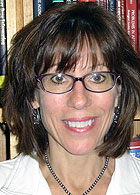Jill B. Firszt, Ph.D., a School of Medicine cochlear-implant specialist, was working on her doctoral dissertation when she met with a 47-year-old patient who had been deaf in one ear since childhood. The patient was to get a cochlear implant in her deaf ear because she recently had a tumor operation that destroyed the hearing in her good ear and left it ineligible for an implant. Firszt knew there wasn’t enough information available about cases like this to predict how well the woman would hear with the implant.
The patient made exceptional progress after her implant surgery, recognizing sentences spoken both in quiet and noise after only three months — much faster than most adults with long-term deafness in both ears who receive cochlear implants.

That patient’s experience inspired Firszt to propose an in-depth study of one-sided or unilateral hearing. She wanted to find out whether hearing in one ear, either natural or because of a cochlear implant, would affect the ability to hear in a deaf ear that receives a cochlear implant. The project has now received a five-year, $3 million grant from the National Institutes of Health (NIH). Collaborators on the project include Rosalie M. Uchanski, Ph.D., research assistant professor of otolaryngology, and Harold Burton, Ph.D., professor of anatomy and neurobiology, of radiology and of cell biology and physiology.
“Patients who have been deaf in both ears for many years often do not achieve the same level of performance as those who have short-term deafness and receive a cochlear implant,” said Firszt, associate professor of otolaryngology and director of the Cochlear Implant Program and Electrophysiology Laboratory. “This patient had long-term deafness in one ear and a short-term deafness in the other. I anticipated that having hearing in one ear for most of her life would improve her outcome with the implant in the long-term deaf ear, but there hadn’t been enough studies to know for sure.”
Normally, each ear sends sounds through a complex auditory system to both the right and left hemispheres of the brain. The sense of sound produced in each hemisphere depends on signals from both ears. That suggests that hearing in only one ear could make it harder for the brain to process some kinds of signals, Firszt said.
On the other hand, even unilateral hearing keeps the right and left hearing centers active, so having sound through one ear might make it easier for the hearing centers to adapt when they suddenly begin getting signals from the other, formerly deaf, ear through a cochlear implant, Firszt said.
Firszt’s NIH-funded project is designed to learn more about the function of the brain’s hearing centers in people with unilateral hearing and subsequent changes when people get cochlear implants.
In one branch of the study, researchers will study bilaterally deaf patients who have one cochlear implant and later get a second implant, and in patients with one deaf ear and one ear with moderate hearing loss who receive an implant in their deaf ear.
In another branch, people who are deaf in one ear will enable the researchers to obtain more specific information about the kinds of hearing difficulties that unilateral hearing entails.
“We’re using imaging techniques such as functional magnetic resonance imaging to look at how different types of sounds are coded in the auditory system,” Firszt said. “When sound input from one ear changes, we expect to see some reorganization of activity in the auditory cortex.”
A second grant, from the WUSTL Institute of Clinical and Translational Sciences, will aid in this kind of analysis. The one-year, $80,000 grant with potential for continued funding in the second year will support research into the time course of brain reorganization when hearing is suddenly lost in one ear. Firszt and colleagues will also implement sound localization training to determine if those with sudden hearing loss can learn to locate sound better, a common problem when a person hears in only one ear.
The results of both studies should provide insight into the consequences of one-sided hearing, help determine how patients can get the maximum hearing improvement from cochlear implants and better enable clinicians to counsel patients on what to expect from their implants. The studies should also help determine whether people with bilateral deafness would benefit from implants in both ears and whether it’s best to get a second implant right away or wait. People interested in participating in these studies can call 747-0882.
Firszt also is adjunct faculty of the Program in Audiology and Communication Sciences (PACS), part of Central Institute for the Deaf at the School of Medicine.